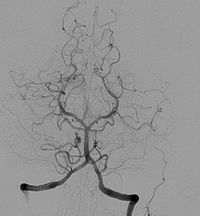
Photo from wikipedia
This study was performed to evaluate the efficacy and safety of endovascular therapy (EVT) by diluted contrast digital subtraction angiography (DSA) in patients with chronic kidney disease (CKD). Patients with… Click to show full abstract
This study was performed to evaluate the efficacy and safety of endovascular therapy (EVT) by diluted contrast digital subtraction angiography (DSA) in patients with chronic kidney disease (CKD). Patients with peripheral artery disease (PAD) often have CKD; thus, EVT carries a risk of contrast-induced nephropathy (CIN). Reducing the amount of contrast medium is, therefore, important in these patients. We developed a novel EVT method using DSA with diluted contrast medium. DSA parameters were adjusted for diluted contrast angiography (1:10 dilution), and we defined this technique as low-concentration DSA (LC-DSA). We retrospectively analyzed 122 patients with CKD [estimated glomerular filtration rate (eGFR), < 45 mL/min/1.73 m2] from June 2012 to November 2017 and classified them into two groups: EVT with diluted contrast (LC-DSA group, n = 63) and conventional EVT (control group, n = 59). Patients with aortoiliac lesions and those undergoing hemodialysis were excluded. The primary endpoint was the incidence of CIN as defined by an absolute increase in serum creatinine of ≥ 0.5 mg/dL or relative increase of ≥ 25% 2–5 days after the procedure. The secondary endpoints were worsening renal function (defined as an eGFR reduction of ≥ 25% compared with that before the procedure), the amount of contrast medium used for EVT, freedom from complications related to LC-DSA, and procedural success. The incidence of CIN was significantly lower in the LC-DSA group than control group (0.0% vs. 11.9%, respectively; P = 0.001). The absolute eGFR increase (4.25 ± 4.7 vs. 1.24 ± 6.9, respectively; P = 0.005) and creatinine decrease ( − 0.16 ± 0.2 vs. 0.007 ± 0.34, respectively; P = 0.0078) were greater in the LC-DSA group than control group. Less contrast medium was used in the LC-DSA group than control group (30.0 ± 14.6 vs. 117.9 ± 52.8 mL, respectively; P < 0.0001). There were no differences in the procedural success rate (100% vs. 96.6%, P = 0.23) or complications related to LC-DSA (0.0% vs. 1.7%, P = 0.48). Therefore, we concluded that EVT with diluted contrast DSA reduced the amount of contrast medium and incidence of CIN. This method is effective and safe for treating patients with CKD who have infrainguinal lesions.
Journal Title: Heart and Vessels
Year Published: 2019
Link to full text (if available)
Share on Social Media: Sign Up to like & get
recommendations!